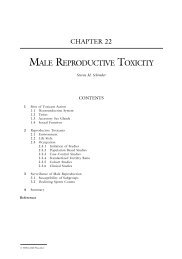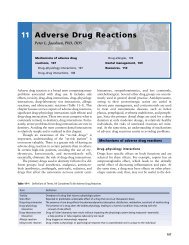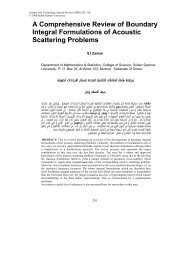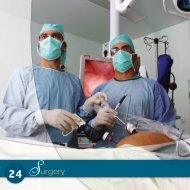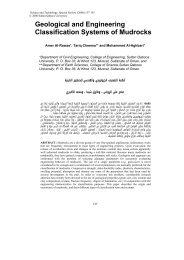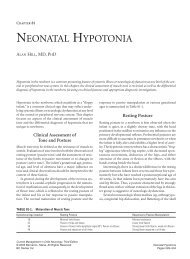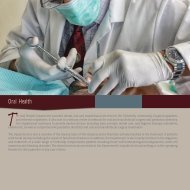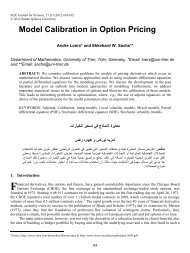Ch05: Red and White Lesions of the Oral Mucosa
Ch05: Red and White Lesions of the Oral Mucosa
Ch05: Red and White Lesions of the Oral Mucosa
Create successful ePaper yourself
Turn your PDF publications into a flip-book with our unique Google optimized e-Paper software.
<strong>Red</strong> <strong>and</strong> <strong>White</strong> <strong>Lesions</strong> <strong>of</strong> <strong>the</strong> <strong>Oral</strong> <strong>Mucosa</strong> 91<br />
FIGURE 5-9 Snuff pouch with a white wrinkled mucosal surface.<br />
appears white <strong>and</strong> is granular or wrinkled (Figure 5-9); in some<br />
cases, a folded character may be seen (tobacco pouch keratosis).<br />
Commonly noted is a characteristic area <strong>of</strong> gingival recession<br />
with periodontal-tissue destruction in <strong>the</strong> immediate area <strong>of</strong> contact<br />
(Figure 5-10). This recession involves <strong>the</strong> facial aspect <strong>of</strong> <strong>the</strong><br />
tooth or teeth <strong>and</strong> is related to <strong>the</strong> amount <strong>and</strong> duration <strong>of</strong><br />
tobacco use. The mucosa appears gray or gray-white <strong>and</strong> almost<br />
translucent. Since <strong>the</strong> tobacco is not in <strong>the</strong> mouth during examination,<br />
<strong>the</strong> usually stretched mucosa appears fissured or rippled,<br />
<strong>and</strong> a “pouch” is usually present. This white tobacco pouch may<br />
become lea<strong>the</strong>ry or nodular in long-term heavy users (Figure 5-<br />
11). Rarely, an erythroplakic component may be seen. The lesion<br />
is usually asymptomatic <strong>and</strong> is discovered on routine examination.<br />
Microscopically, <strong>the</strong> epi<strong>the</strong>lium is hyperkeratotic <strong>and</strong> thickened.<br />
A characteristic vacuolization or edema may be seen in <strong>the</strong><br />
keratin layer <strong>and</strong> in <strong>the</strong> superficial epi<strong>the</strong>lium. Frank dysplasia is<br />
uncommon in tobacco pouch keratosis. 62<br />
FIGURE 5-10 Snuff pouch showing extensive periodontal tissue<br />
destruction <strong>and</strong> a thickened area <strong>of</strong> leukoplakia. (Courtesy <strong>of</strong> Dr. Robert<br />
Howell, West Virginia University, School <strong>of</strong> Dentistry)<br />
FIGURE 5-11 <strong>White</strong> lea<strong>the</strong>ry nodular tobacco pouch. These thickened<br />
areas are more worrisome for malignant transformation.<br />
TREATMENT AND PROGNOSIS<br />
Cessation <strong>of</strong> use almost always leads to a normal mucosal<br />
appearance within 1 to 2 weeks. 54,64,65 Biopsy specimens<br />
should be obtained from lesions that remain after 1 month.<br />
Biopsy is particularly indicated for those lesions that appear<br />
clinically atypical <strong>and</strong> that include such features as surface<br />
ulceration, erythroplakia, intense whiteness, or a verrucoid or<br />
papillary surface. 53, 62, 64 The risk <strong>of</strong> malignant transformation<br />
is increased fourfold for chronic smokeless tobacco users. 66<br />
Nicotine Stomatitis<br />
Nicotine stomatitis (stomatitis nicotina palati, smoker’s palate)<br />
refers to a specific white lesion that develops on <strong>the</strong> hard <strong>and</strong> s<strong>of</strong>t<br />
palate in heavy cigarette, pipe, <strong>and</strong> cigar smokers. The lesions are<br />
restricted to areas that are exposed to a relatively concentrated<br />
amount <strong>of</strong> hot smoke during inhalation.Areas covered by a denture<br />
are usually not involved. The lesion has become less common<br />
since pipe smoking has lost popularity. Although it is associated<br />
closely with tobacco smoking, <strong>the</strong> lesion is not considered<br />
to be premalignant. 67–69 Interestingly, nicotine stomatitis also<br />
develops in individuals with a long history <strong>of</strong> drinking extremely<br />
hot beverages. 70 This suggests that heat, ra<strong>the</strong>r than toxic chemicals<br />
in tobacco smoke, is <strong>the</strong> primary cause. Prevalence rates as<br />
high as 1.0 to 2.5% have been reported in populations <strong>of</strong> different<br />
cultures. 69–72 “Reverse smoking”(ie, placing <strong>the</strong> burning end<br />
<strong>of</strong> <strong>the</strong> cigarette in <strong>the</strong> oral cavity), seen in South American <strong>and</strong><br />
Asian populations, produces significantly more pronounced<br />
palatal alterations that may be erythroleukoplakic <strong>and</strong> that are<br />
definitely considered premalignant. 73<br />
TYPICAL FEATURES<br />
This condition is most <strong>of</strong>ten found in older males with a history<br />
<strong>of</strong> heavy long-term cigar, pipe, or cigarette smoking. Due<br />
to <strong>the</strong> chronic insult, <strong>the</strong> palatal mucosa becomes diffusely gray<br />
or white (Figure 5-12, A). Numerous slightly elevated papules<br />
with punctate red centers that represent inflamed <strong>and</strong> metaplastically<br />
altered minor salivary gl<strong>and</strong> ducts are noted.





